This is a question many people are asking recently. According to Airbus, The Boeing Company & Embraer research, the risk of inflight COVID-19 transmission appears to be low if passengers are following recommended safety measures.

Source: The International Air Transport Association (IATA)
“The risk of a passenger contracting COVID-19 while onboard appears very low. With only 44 identified potential cases of flight-related transmission among 1.2 billion travelers, that’s one case for every 27 million travelers. We recognize that this may be an underestimate but even if 90% of the cases were unreported, it would be one case for every 2.7 million travelers. We think these figures are extremely reassuring. Furthermore, the vast majority of published cases occurred before the wearing of face coverings inflight became widespread,” said Dr. David Powell, IATA’s Medical Advisor.
According to the IATA and Aircraft companies, the new protocols implanted on airports and aircraft design characteristics add a further protection layer, contributing to the low incidence of inflight transmission. These include:
- Limited face-to-face interactions as passengers face forward and move about very little
- The effect of the seat-back acting as a physical barrier to air movement from one row to another
- The minimization of forward-aft flow of air, with a segmented flow design which is directed generally downward from ceiling to floor
- The high rate of fresh air coming into the cabin. Air is exchanged 20-30 times per hour onboard most aircraft, which compares very favorably with the average office space (average 2-3 times per hour) or schools (average 10-15 times per hour).
- The use of HEPA filters which have more than 99.9% bacteria/virus removal efficiency rate ensuring that the air supply entering the cabin is not a pathway for introducing microbes.
For more information and details: https://www.iata.org/en/pressroom/pr/2020-09-08-012/





